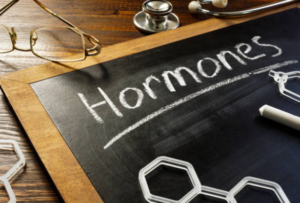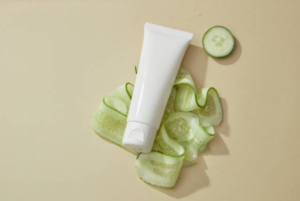Hormonal Havoc

In the realm of beauty, we often focus on achieving flawless skin, luscious hair, and captivating makeup looks. However, what many fail to recognize are the potential repercussions of the products we slather onto our bodies daily. From moisturizers to shampoos, cosmetics to fragrances, the ingredients in these products can wreak havoc on our hormonal health. In this blog, we delve into the hidden dangers lurking within beauty products and their impact on hormonal balance.
Hormones are intricate chemical messengers that regulate numerous bodily functions, playing a pivotal role in maintaining overall health and well-being. Produced by various glands such as the pituitary, thyroid, adrenal, pancreas, and reproductive organs, hormones orchestrate essential processes including metabolism, growth and development, immune function, mood regulation, and reproduction.
Key Hormones and Their Functions
- Estrogen: Often referred to as the “female hormone,” estrogen plays a crucial role in the development of secondary sexual characteristics in women, regulation of the menstrual cycle, bone health, and cognitive function. However, it also plays a role in men’s health, contributing to bone density, libido, and cardiovascular health.
- Progesterone: Progesterone works in tandem with estrogen to regulate the menstrual cycle and support pregnancy. It helps maintain the uterine lining to facilitate implantation and supports fetal development during pregnancy.
- Testosterone: Although primarily known as the “male hormone,” testosterone is also present in females, albeit in smaller quantities. It influences libido, muscle mass, bone density, mood, and cognitive function in both men and women.
- Thyroid Hormones: Produced by the thyroid gland, thyroid hormones (thyroxine or T4 and triiodothyronine or T3) regulate metabolism, body temperature, heart rate, and energy levels. An imbalance in thyroid hormones can lead to symptoms such as fatigue, weight changes, and mood disturbances.
- Cortisol: Known as the “stress hormone,” cortisol helps the body respond to stress by regulating blood sugar levels, metabolism, and immune function. Chronic stress can lead to dysregulation of cortisol levels, impacting sleep, mood, and overall health.

The Link Between Beauty Products and Hormonal Health
The beauty industry is vast and diverse, offering a plethora of products designed to enhance physical appearance and promote self-care. However, lurking beneath the allure of glossy advertisements and enticing packaging are hidden dangers that can disrupt hormonal health. Many conventional beauty products contain a cocktail of synthetic chemicals, some of which have been identified as endocrine disruptors—substances that interfere with the body’s hormonal system.
Endocrine disruptors can mimic, block, or interfere with the production, release, transport, metabolism, binding, action, or elimination of natural hormones in the body. These chemicals can exert their effects through various mechanisms, including:
- Estrogenic Activity: Some endocrine disruptors have estrogen-mimicking properties, meaning they can bind to estrogen receptors in the body and elicit estrogenic effects. This can lead to estrogen dominance, characterized by an imbalance between estrogen and progesterone levels, which may contribute to reproductive health issues, hormone-related cancers, and other estrogen-dependent conditions.
- Androgenic Activity: Other endocrine disruptors may exhibit androgenic (testosterone-like) activity, interfering with androgen receptors and disrupting hormonal balance. This can affect reproductive health, libido, androgen-dependent conditions such as acne and hirsutism (excessive hair growth), and may even contribute to hormonal imbalances in men.
- Thyroid Disruption: Some endocrine disruptors can interfere with thyroid function by inhibiting thyroid hormone synthesis, disrupting thyroid hormone transport, or altering thyroid hormone metabolism. This can lead to hypothyroidism (underactive thyroid) or hyperthyroidism (overactive thyroid), affecting metabolism, energy levels, mood, and overall health.
Common Endocrine Disruptors in Beauty Products
The beauty industry utilizes a wide range of synthetic chemicals to enhance product performance, texture, fragrance, and shelf life. Unfortunately, many of these chemicals have been identified as endocrine disruptors—substances that interfere with the body’s hormonal system and can lead to a myriad of health concerns. Here are some of the most prevalent endocrine disruptors found in beauty products:
- Parabens:Parabens are a group of synthetic preservatives commonly used in cosmetics, skincare, haircare, and personal care products to prevent microbial growth and extend shelf life. These chemicals, including methylparaben, ethylparaben, propylparaben, and butylparaben, are added to products such as moisturizers, lotions, shampoos, conditioners, and deodorants.
Despite their widespread use, parabens have raised concerns due to their potential estrogenic activity. Studies have shown that parabens can mimic the hormone estrogen in the body, leading to estrogenic effects such as increased cell proliferation and hormone disruption. Parabens have been detected in human tissues and bodily fluids, including breast tissue, urine, and blood, raising concerns about their potential role in breast cancer development and reproductive health issues.
- Phthalates:Phthalates are a group of synthetic chemicals used as plasticizers to impart flexibility, durability, and resilience to plastics. These chemicals are also found in fragrances, nail polishes, hair sprays, and other personal care products to enhance fragrance retention, improve product performance, and increase flexibility.
Phthalates are known endocrine disruptors, with evidence suggesting they can interfere with hormone signaling and disrupt hormonal balance. Studies have linked phthalate exposure to adverse reproductive outcomes, including decreased sperm quality, reduced fertility, and reproductive organ abnormalities. Phthalates have also been associated with hormone-related cancers, metabolic disorders, and developmental abnormalities in children exposed prenatally.
- Triclosan:Triclosan is an antimicrobial agent used in antibacterial soaps, hand sanitizers, toothpaste, deodorants, and other personal care products to inhibit the growth of bacteria and fungi. Despite its widespread use, triclosan has come under scrutiny due to its potential adverse effects on hormonal health and environmental toxicity.
Triclosan has been shown to interfere with thyroid function by inhibiting thyroid hormone synthesis, disrupting thyroid hormone transport, and altering thyroid hormone metabolism. This can lead to thyroid dysfunction, including hypothyroidism, hyperthyroidism, and thyroid nodules. Additionally, triclosan has been associated with hormone disruption, reproductive health issues, and antibiotic resistance, prompting regulatory action to restrict its use in certain products.
- Sodium Lauryl Sulfate (SLS) and Sodium Laureth Sulfate (SLES):SLS and SLES are surfactants commonly used in shampoos, cleansers, body washes, toothpaste, and other personal care products to create foam and lather. While not classified as endocrine disruptors, these chemicals can irritate the skin, disrupt the skin barrier function, and strip the skin of its natural oils.
Prolonged or excessive exposure to SLS and SLES can compromise the skin’s protective barrier, leading to dryness, irritation, and inflammation. This can exacerbate skin conditions such as eczema, dermatitis, and psoriasis, and may contribute to skin sensitization and allergic reactions. While SLS and SLES are generally considered safe for use in cosmetics at low concentrations, individuals with sensitive skin or underlying skin conditions may be more susceptible to adverse effects.
- Benzophenones:Benzophenones, including oxybenzone, avobenzone, octocrylene, and octinoxate, are commonly used as UV filters in sunscreen and other sun protection products to absorb and scatter UV radiation. While benzophenones are effective at preventing sunburn and protecting against UV-induced skin damage, they have been identified as potential endocrine disruptors.
Benzophenones can mimic estrogen in the body and interfere with hormone signaling, potentially disrupting hormonal balance and contributing to reproductive health issues. Oxybenzone, in particular, has received attention due to its potential hormone-disrupting effects and environmental persistence. Some studies have suggested a possible link between oxybenzone exposure and reduced fertility, hormone-related cancers, and developmental abnormalities in aquatic organisms.

The Impact on Hormonal Health
The constant exposure to these endocrine disruptors through beauty products can have far-reaching consequences on hormonal health. For instance, estrogen-mimicking chemicals like parabens may contribute to estrogen dominance, leading to conditions such as fibroids, endometriosis, and breast cancer. Similarly, phthalates have been linked to reduced fertility, birth defects, and hormone-related cancers.
Furthermore, hormonal imbalances can manifest externally, affecting the skin, hair, and nails. Acne, dryness, premature aging, and hair loss are just a few of the dermatological issues that may arise from disrupted hormonal function.
Given the potential risks associated with endocrine disruptors in beauty products, it is imperative to adopt proactive measures to minimize exposure and safeguard hormonal balance. Here are some comprehensive strategies for protecting your hormonal health:
- Read Ingredient Labels Thoroughly:Understanding the ingredients in beauty products is essential for making informed choices. Take the time to scrutinize ingredient labels and familiarize yourself with common endocrine disruptors such as parabens, phthalates, triclosan, SLS, SLES, and synthetic fragrances. Avoid products containing these chemicals, opting instead for cleaner alternatives formulated with natural, organic, and plant-based ingredients.
- Choose Natural and Organic Products:Opt for beauty products made with certified organic ingredients that are free from synthetic chemicals, pesticides, and genetically modified organisms (GMOs). Look for reputable certifications such as USDA Organic, COSMOS Organic, and EWG Verified, which indicate that products meet rigorous standards for purity and integrity. Natural and organic beauty products are often formulated with botanical extracts, essential oils, and nourishing plant-based ingredients that support skin health without disrupting hormonal balance.
- Minimize Fragrance Exposure:Fragrances are a common source of phthalates and other synthetic chemicals in beauty products. Choose fragrance-free or naturally scented products whenever possible, and be wary of synthetic fragrances listed as “parfum,” “fragrance,” or “perfume” on ingredient labels. Consider using unscented or lightly scented products formulated with essential oils or botanical extracts for a safer alternative to synthetic fragrances.
- DIY Beauty Solutions:Explore do-it-yourself (DIY) beauty recipes using simple, natural ingredients found in your kitchen or garden. Homemade beauty treatments offer a cost-effective and customizable alternative to commercial products, allowing you to tailor formulations to your specific skincare needs. From facial masks and scrubs to hair treatments and body oils, there are numerous DIY beauty solutions that can promote radiant skin and healthy hair without exposing you to harmful chemicals.
- Support Clean Beauty Brands:Choose beauty brands that prioritize transparency, sustainability, and ingredient integrity, and support initiatives to eliminate harmful chemicals from personal care products. Look for brands that are certified by reputable organizations such as the Environmental Working Group (EWG), Made Safe, and the Campaign for Safe Cosmetics, which advocate for safer alternatives and disclose ingredient lists in full transparency. By supporting clean beauty brands, you can encourage industry-wide reform and promote safer, more sustainable practices.
- Advocate for Regulatory Reform:Advocate for stricter regulations and oversight of the beauty industry to ensure the safety and efficacy of personal care products. Write to lawmakers, sign petitions, and support grassroots initiatives calling for stronger consumer protections and stricter ingredient regulations. By raising awareness and demanding accountability from policymakers and industry stakeholders, you can help drive positive change and protect public health.
- Educate Yourself and Others:Stay informed about emerging research on endocrine disruptors and their impact on hormonal health, and share your knowledge with friends, family, and community members. Empower others to make informed choices about the products they use and encourage them to prioritize their hormonal health. By fostering a culture of awareness and accountability, you can contribute to a healthier, more informed society.

While the allure of beauty products may be irresistible, it’s crucial to prioritize your hormonal health. The hidden dangers of endocrine disruptors lurking within these products can have profound and long-lasting effects on your well-being. By being vigilant about ingredient labels, opting for natural alternatives, and advocating for clean beauty practices, you can protect yourself and future generations from the hormonal havoc caused by beauty products. Remember, true beauty begins with health, inside and out.




